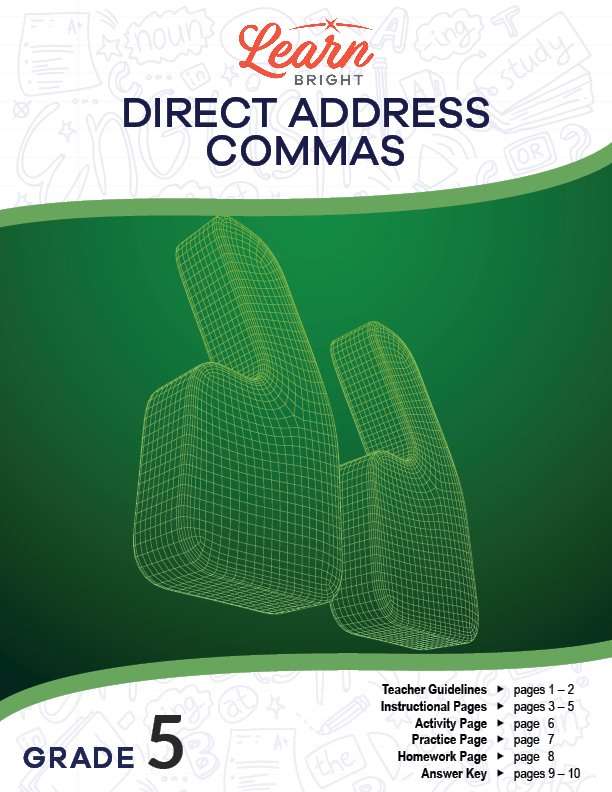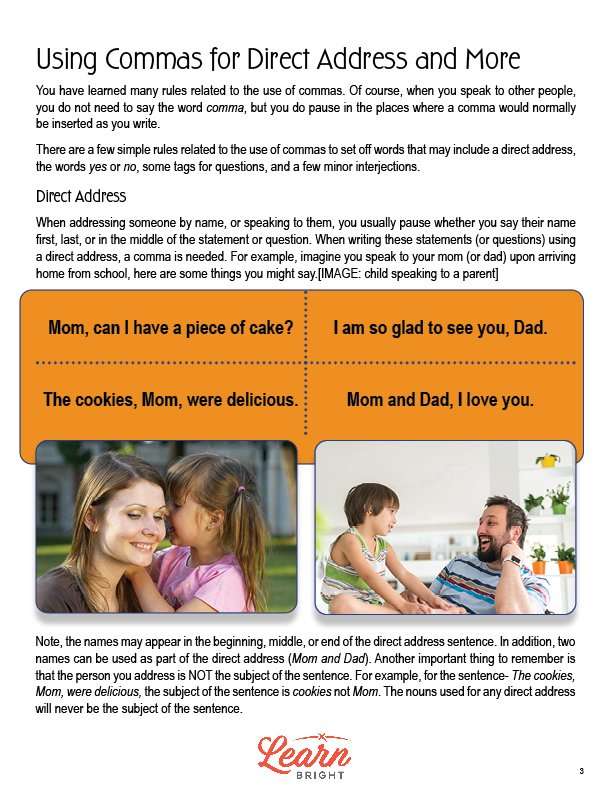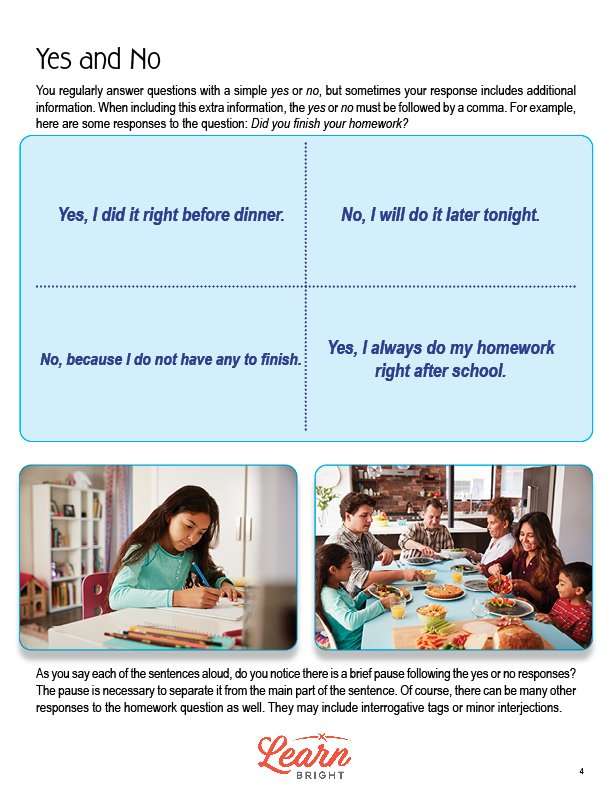Description
What our Direct Address Commas lesson plan includes
Lesson Objectives and Overview: Direct Address Commas teaches students how to use commas correctly for a direct address. At the end of the lesson, students will be able to use a comma to set off the words yes and no, to set off a tag question from the rest of the sentence, and to indicate direct address. This lesson is for students in 5th grade.
Classroom Procedure
Every lesson plan provides you with a classroom procedure page that outlines a step-by-step guide to follow. You do not have to follow the guide exactly. The guide helps you organize the lesson and details when to hand out worksheets. It also lists information in the green box that you might find useful. You will find the lesson objectives, state standards, and number of class sessions the lesson should take to complete in this area. In addition, it describes the supplies you will need as well as what and how you need to prepare beforehand. To prepare for this lesson ahead of time, you can pair students for the activity and copy the handouts.
Options for Lesson
Included with this lesson is an “Options for Lesson” section that lists a number of suggestions for activities to add to the lesson or substitutions for the ones already in the lesson. One optional addition to the lesson activity is to have students create a poster using their sentences, adding pictures as needed; you can also include additional names and words to make the activity longer. An optional addition to the lesson is to use current reading content or other texts and have students identify direct addresses, yes/no statements, and more. Students can also create a quiz for other students to complete. You can also hold a “Direct Address and Other Commas Bee,” where you read sentences aloud and have teams of students guess the placement of the comma. Finally, you can have students speak aloud during their normal conversations and say the word “comma” out loud after each direct address name, yes/no statement, and wherever else they’re needed.
Teacher Notes
The teacher notes page includes a paragraph with additional guidelines and things to think about as you begin to plan your lesson. This page also includes lines that you can use to add your own notes as you’re preparing for this lesson.
DIRECT ADDRESS COMMAS LESSON PLAN CONTENT PAGES
Using Commas for Direct Address and More
The Direct Address Commas lesson plan includes three content pages. The lesson begins by reminding students that they’ve already learned many comma rules. When you speak aloud, you don’t say the word comma, but you do pause. This lesson covers some additional comma rules related to direct address commas, yes/no statements, and more.
Direct Address
When you talk to someone or address them by name, you pause when you say their name, wherever it is in a sentence. When you write statements or questions using a direct address, you need to use a comma. If you’re speaking to a parent, you might say Mom, can I have a piece of cake? Note the comma in that question after the word Mom. The lesson includes other examples as well.
Names can appear in the beginning, middle, or at the end of a direct address sentence. We can also use two names (Mom and Dad, for example). It’s important to remember that the person or people you address are not the subject of the sentence. The nouns that you use for direct address will never be the subject of the sentence.
Yes and No
It’s normal to answer questions with a simple yes or no, but you will sometimes need to include additional information in your response. When you include extra information, you need to follow the yes or no with a comma. The lesson includes some examples, including: Yes, I did it right before dinner. In this example, we place a comma right after the word yes.
If you say each example sentence aloud, you’ll notice that you naturally pause after the yes or no. This pause helps separate it from the main part of the sentence.
Other Uses for this Type of Comma
Finally, students will learn that there are several other ways to use this type of comma, other than direct address and yes/no responses. The lesson includes many examples. Some of these examples include: Well, I tried to finish it. and Of course, I always do my homework. These sentences have minor interjections or other words that we need to set off by a comma. We can also combine some sentences like this with direct address statements, like in the sentence No, I will not go to the store, Thomas.
Sometimes, you will also need to set off a tag question from the rest of a sentence using a comma, like in the example You have a game tonight, don’t you? It’s important to include the comma in these kinds of sentences to help the reader understand the tagged question.
There are many different ways to use commas, and it can feel confusing. However, if you read the sentences out loud, you can discover that a pause in speaking usually indicates the place where the commas needs to go. However, it’s very important not to include unnecessary commas.
DIRECT ADDRESS COMMAS LESSON PLAN WORKSHEETS
The Direct Address Commas lesson plan includes three worksheets: an activity worksheet, a practice worksheet, and a homework assignment. You can refer to the guide on the classroom procedure page to determine when to hand out each worksheet.
CREATE SENTENCES ACTIVITY WORKSHEET
Students will work with a partner to complete the activity worksheet. Each pair will use the provided direct address names, yes/no, and other words to create 15 sentences. They’ll use each word once, making sure to be creative with the other parts of the sentences.
Students can also work alone or in groups for this activity.
INSERT COMMAS PRACTICE WORKSHEET
For the practice worksheet, students will read sentences and insert commas where needed. Some sentences will require more than one comma.
DIRECT ADDRESS COMMAS HOMEWORK ASSIGNMENT
The homework assignment asks students to answer each question listed with a yes, no, maybe, or another word. They should include additional information and make sure to use correct punctuation.
Worksheet Answer Keys
This lesson plan includes answer keys for the practice worksheet and the homework assignment. If you choose to administer the lesson pages to your students via PDF, you will need to save a new file that omits these pages. Otherwise, you can simply print out the applicable pages and keep these as reference for yourself when grading assignments.









